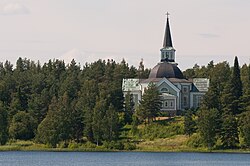Top Qs
Timeline
Chat
Perspective
Ruokolahti
Municipality in South Karelia, Finland From Wikipedia, the free encyclopedia
Remove ads
Ruokolahti (Finnish: [ˈruo̯koˌlɑhti]; Swedish: Ruokolax;[5] literally translated the "Reed Bay") is a municipality of Finland, situated in south-eastern Finland, in the region of South Karelia. Neighbouring municipalities are Imatra, Lappeenranta, Taipalsaari, Puumala, Sulkava, Punkaharju, Parikkala and Rautjärvi. Ruokolahti covers an area of 1,219.85 square kilometres (470.99 sq mi) of which 23% is water.[1]
The municipality has 4,721 inhabitants (30 June 2025),[2] but the population doubles in summer as holidaymakers occupy the 3,000 summer cottages in the region.[6]
Ruokolahti is known for its natural environment, for example Kummakivi is a balancing rock located at 61° 29' 36.4596" N, 28° 25' 45.5016" E in Ruokolahti[7] and is protected.[8] In the west there is the Lake Saimaa and in the east there are hundreds of smaller lakes. The Salpausselkä ridges run through the area.[6] In 2025, The Times highlights the Huuhanranta beach on the shores of Lake Saimaa among the attractions of Ruokolahti, referring it as the "Saimaa Riviera".[9]
The famous sniper Simo Häyhä, also knows as nickname the "White Death", lived in Ruokolahti for 57 years after the 1939–40 Winter War.[10] He is buried there in the graveyard of Ruokolahti Church.
The municipal coat of arms of Ruokolahti is a canting arms that directly refers to the name of the municipality, including reeds appearing in it. Wave line is usually used to describe a local body of water. The coat of arms was designed by Gustaf von Numers and was confirmed for use on September 11, 1951.[11]
Remove ads
Gallery
- Document donated to the Church
by Marshal C. G. E. Mannerheim - The grave of Simo Häyhä
References
External links
Wikiwand - on
Seamless Wikipedia browsing. On steroids.
Remove ads









